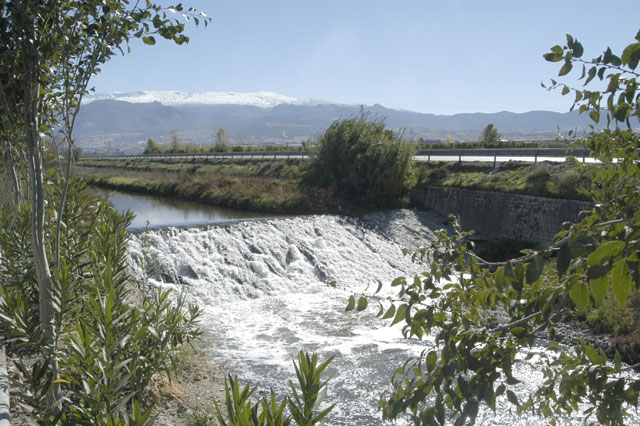Dams, barriers and locks
Humans have fragmented European water bodies with dams, barriers (e.g. weirs) and locks for centuries, as a means of ensuring water supplies, generating energy, facilitating navigation and controlling flooding. Such human-made barriers reduce the ecological connectivity of a water body, impeding the flows of water, nutrients and sediment; create obstructions for species movement (particularly migratory species); often alter the quantity, quality and timing of river flows, both upstream and downstream; and can impact surrounding riparian zones and flood plains, which often provide valuable biodiversity habitat and ecosystem services for humans, in various ways from permanent inundation (reservoirs) to complete decoupling and drying out. Large dams have altered the character of water bodies entirely from rivers and transitional waters to reservoirs with predominating lacustrine conditions.
Pressure types
There are a number of point source pressures generated by different drivers:
Energy
Hydropower - dam and weir construction is often undertaken in order to generate hydropower which harnesses the energy of moving water, both on a large scale (e.g. the Kölnbrein Dam in Austria, which supports four hydropower plants) and much smaller scale (e.g. ‘run of the river’ hydropower weirs which may serve a small number of households).
Agriculture
Irrigation reservoirs - many agricultural practices in Europe require large quantities of water, particularly in water-scarce areas of Southern Europe. As a result, irrigation reservoirs are often created to store water and ensure supplies during periods of low rainfall.
Weirs - many lowland streams are regulated by a combination of channelisation and weirs to control both the discharge capacity and retain water.
Industry
Water storage - some industrial processes are water-intensive, and dams and barriers have been built on adjacent water bodies to create water storage reservoirs for processes such as cooling.
Flood protection
Flood protection - in low lying coastal areas of Northern Europe, dykes (often spanning tens of kilometres) have been created to ‘reclaim’ land from the sea in areas known as ‘polder’ (e.g. the Zuiderzee Works in The Netherlands) which help buffer flooding from transitional waters, but also significantly alter the hydromorphology of surrounding water bodies.
Urban development
Reservoir creation - urban populations require reliable supplies of clean water for drinking, washing, cooking and cleaning, and most significant human settlements across Europe are supplied by a network of human-made reservoirs, often created through the damming of existing rivers and streams. Poorly maintained reservoirs can experience environmental issues such as algal blooms which impair the ability to provide drinking water and can become a human health hazard and a threat to ecosystem status.
Recreation - reservoirs are often popular sites for recreational activities such as boating and angling. Sport angling can often lead to the introduction of non-native species (such as the brook trout), which may impact remaining native biodiversity.
Geographical distributions and trends
There are currently around 7,000 large dams (larger than 10-15 metres in height) and thousands more smaller dams across Europe, with many located in Scandinavia and the Alps where hydropower generation is high (EEA 2012, EEA 2016). Smaller barriers or ‘transverse’ structures are common across the continent, for example there are around 200,000 transverse structures in Germany on network of watercourses of around 400,000 km (EEA 2012).
Spain has the largest number of reservoirs (many of which are used for irrigation) in Europe, with around 1,200 (EEA 2008). Many of the last remaining ‘un-fragmented’ rivers in Europe are located in the Balkans, however, there are over 1,600 proposed hydropower plants for rivers in the region, around half of which are located in existing protected areas (RiverWatch 2015). The map presents the global hydropower dams over 1 MW capacity that are under construction or planned (Zarfl et al. 2017, map downloaded from BIOFRESH Atlas).
Stressors generated
Diffuse pressures predominantly generate chemical stressors, arising from the enrichment of nutrients which can cause eutrophication, algal blooms, turbid waters and oxygen depletion (EEA 2008). Morphological stressors may also be generated as algal blooms and fine sediments clog fish spawning areas and other aquatic habitats.
Potential for mitigation
The mitigation of barrier pressures in rivers is a key strategy for ‘re-naturation’ restoration management, both at a small scale (e.g. the removal of small weirs, or installation of fish ladders) and a large scale (e.g. the decommissioning and demolition of large dams, such as the 23 metre high Robledo de Chavela dam on the Cofio River in Spain in 2014). However, as dams amplify a range of valuable ecosystem services such as drinking water supply and hydropower production, there are significant demands for their continued construction and use across Europe (RiverWatch 2015).
Further reading
Reports and publications:
Zarfl, C., A.E. Lumsdon, J. Berlekamp, L. Tydecks & K. Tockner (2015). A global boom in hydropower dam construction. Aquatic Sciences 77:161-170 DOI: 10.1007/s00027-014-0377-0 ((Read abstract)).
EEA (2008). Reservoirs and dams (Download report, 93kb)
EEA (2012). European waters - assessment of status and pressures (Download report, 28mb)
EEA (2016). Dams with reservoirs on rivers in Europe (Download report, 423kb)
River Watch (2015). Hydropower Projects in Protected Areas on the Balkans (Download report, 6.41mb)
Selected Freshwater blogs:
Freshwaterblog (2011). Dam construction poses potential threats to Turkish freshwater biodiversity (External website)
Freshwaterblog (2012). The effect of dams on fish biodiversity: A global view. (External website)
Freshwaterblog (2012). A Dam Controversy: Laos dam project poses threat to Mekong ecosystem and communities (External website)
Freshwaterblog (2015). River Obstacles: crowdsourcing river fragmentation using a mobile app (External website)
Freshwaterblog (2015). Using microscopic fungi to understand the impact of dams on rivers (External website)
Freshwaterblog (2017). The politics of biodiversity and hydropower on ‘Europe’s last wild river’ (External website)
Other Websites:
Zarfl, C., A.E. Lumsdon, J. Berlekamp, L. Tydecks & K.Tockner (2017). Global Hydropower Dams (> 1 MW) under Construction or Planned. Accessed through the Global Freshwater Biodiversity Atlas (atlas.freshwaterbiodiversity.eu) on 09/11/2017.
Dam removal Europe - European Dam Removal Map (External website)
Dam removal Europe - Robledo de Chavela, Spain (External website)








